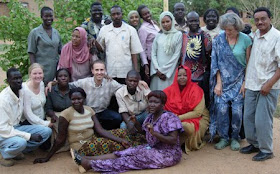
Medieval empires of Ghana, Mali, and Songhai that contrrolled Western Sudan had no fixed geopolitical boundaries or singular ethnic or national identities . The Islamic impact on these empires is usuallly related to the extensive trading networks and trns-Saharan commerce which was developed in the 7th century by Arab and Berbers.The Savanna region is hospitable to both agriculture and livestockbreeding as well as it is ideally situated for trade. Such properties made the region more attractive to Arab from north Africa to impose Islamic culture while seeking for a rich diversity of goods represented in gold and salt as well as searching for grazing land for their animals.

By the 6th century three states had emerged as the political and cultural heirs of the Meroitic Kingdom . Nobatia is the north , also known as Ballanah , had to capital at Faras, in what is now Egypt, the central kingdom , Makuria, was centered at Dunqulah, about 13,000 kms south of modern Dunqulah , and Alawa , in the heartland of old Meroe , which had its capital at Sawba (modern day Khartoum). After many attempts at Military conquest failed, the Arab commander in Egypt concluded in a series of treaties with the Nubians which lasted more nearly 700 years.

Attempt for establishing peace between the two regions of two relions was made even today . The peace agreement between rhe north and south of Sudan was signed in one and half years ago of Sept. 2006.
 Medieval empires of Ghana, Mali, and Songhai that contrrolled Western Sudan had no fixed geopolitical boundaries or singular ethnic or national identities . The Islamic impact on these empires is usuallly related to the extensive trading networks and trns-Saharan commerce which was developed in the 7th century by Arab and Berbers.The Savanna region is hospitable to both agriculture and livestockbreeding as well as it is ideally situated for trade. Such properties made the region more attractive to Arab from north Africa to impose Islamic culture while seeking for a rich diversity of goods represented in gold and salt as well as searching for grazing land for their animals.
Medieval empires of Ghana, Mali, and Songhai that contrrolled Western Sudan had no fixed geopolitical boundaries or singular ethnic or national identities . The Islamic impact on these empires is usuallly related to the extensive trading networks and trns-Saharan commerce which was developed in the 7th century by Arab and Berbers.The Savanna region is hospitable to both agriculture and livestockbreeding as well as it is ideally situated for trade. Such properties made the region more attractive to Arab from north Africa to impose Islamic culture while seeking for a rich diversity of goods represented in gold and salt as well as searching for grazing land for their animals. By the 6th century three states had emerged as the political and cultural heirs of the Meroitic Kingdom . Nobatia is the north , also known as Ballanah , had to capital at Faras, in what is now Egypt, the central kingdom , Makuria, was centered at Dunqulah, about 13,000 kms south of modern Dunqulah , and Alawa , in the heartland of old Meroe , which had its capital at Sawba (modern day Khartoum). After many attempts at Military conquest failed, the Arab commander in Egypt concluded in a series of treaties with the Nubians which lasted more nearly 700 years.
By the 6th century three states had emerged as the political and cultural heirs of the Meroitic Kingdom . Nobatia is the north , also known as Ballanah , had to capital at Faras, in what is now Egypt, the central kingdom , Makuria, was centered at Dunqulah, about 13,000 kms south of modern Dunqulah , and Alawa , in the heartland of old Meroe , which had its capital at Sawba (modern day Khartoum). After many attempts at Military conquest failed, the Arab commander in Egypt concluded in a series of treaties with the Nubians which lasted more nearly 700 years. 
